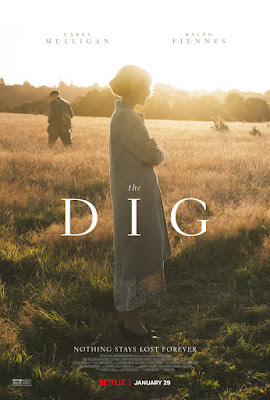Stream it on Netflix
The Dig is a simple character drama with one small technical issue, which I’ll get to in a moment. It’s not a terrible problem that bogs down the film's overall quality, but it is one that I found to be a bit distracting and, as the title of this review announces, confusing. Nitpicks aside, The Dig is still a well-crafted drama with convicted performances throughout the whole cast, spot-on direction, and writing that manages to occasionally sing like poetry. If only this one issue wasn’t so prevalent.
Set in England around the beginning of WW2, the story follows a middle-aged mother named Edith (Carey Mulligan), who believes there to be something unusual buried in the ground of her property. She hires an experienced archeologist and excavator named Basil (Ralph Fiennes) to assist in the digging and potential preservation of whatever they may find. Soon after they get started, sure enough, they find the remains of an ancient ship beneath the dirt, along with a few other treasures and clues about its origin. This catches the pompous archeological society's attention, who demand they take over the dig and claim whatever is found. This causes a bit of tension between Edith and the society, not at all helped by some potential romantic tension between her and Basil.
For the most part, the film is a pleasant watch. The characters are likable, the cinematography is pretty, the story is interesting, and the bits of history are well discussed, explored, and fascinating. It succeeds in making an otherwise potentially dull premise totally engaging by focusing more on the characters and their relationships with each other. It may not have much in the way of high stakes, but it delivers a compelling human narrative.
My only issue with the film is with its baffling editing choices. Mainly its overuse of J-cuts and L-cuts.
For those who don’t know or need a quick refresher, J-cuts and L-cuts refer to a specific editing technique about the relationship between a movie's picture and sound. In most editing platforms, the picture and sound files are separate from each other and can be manipulated independently.
J-cuts and L-cuts are when the editor extends the audio from one clip and plays it over a different video clip. This is normally used as a means of transitioning from one scene to another. When it is applied in the editing timeline, the cuts can resemble a J or an L.
My issue with its use in The Dig is that, for some reason, large chunks of the movie utilize this particular editing technique. Some scenes will play out for a solid minute like this.
One argument that could be had is that it’s a means of condensing large passages of time within a smaller space, which is a fine trick when utilized well. Even so, if that was the intention, I can’t help but feel as if they relied upon this trick a bit too much. Most of the scenes that use this tactic don’t feel like they require any L-cuts or J-cuts, or at least not as many as they end up using.
Despite this nitpick, I do still recommend this film for a pleasant afternoon watch. It’s mellow, well-acted, and has just enough intrigue sprinkled throughout the story to keep it engaging.
Check this one out.
Ladies & gentlemen, I am TheNorm; thank you all for reading.








No comments:
Post a Comment